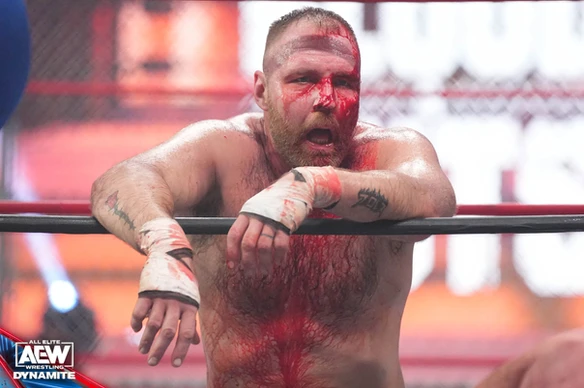
Jon Moxley suffered a minor concussion this past Wednesday on AEW Dynamite: Grand Slam, after getting hurt in the first minute of his AEW International Title defense against Rey Fenix.
Moxley caught Fenix on a dive but the latter landed on his head, with the back of his head hitting the floor.
Following the match, Moxley told people backstage that he was okay, but during the bout, he realized something was off and called an audible to alter the outcome of the match.
The Wrestling Observer Newsletter is reporting that Moxley stated that since he was knocked out, neither Fenix nor referee Rick Knox realized he was hurt. In fact, the ringside doctor also failed to realize that the former AEW World Champion had suffered a concussion.
When Moxley got backstage, he was diagnosed with a mild concussion, or a low-grade/grade 1.
You can keep up with all your wrestling news right here on eWrestlingNews.com. Or, you can follow us over on our Twitter and Facebook pages.
Title: Jon Moxley Suffers Minor Concussion During AEW Dynamite: Grand Slam
Introduction:
Professional wrestler Jon Moxley recently suffered a minor concussion during his AEW International Title defense against Rey Fenix on AEW Dynamite: Grand Slam. The incident occurred when Fenix landed on his head after Moxley caught him on a dive. Despite initially appearing fine, Moxley later realized something was off and made the decision to alter the outcome of the match. This article will delve into the details of the incident and shed light on the importance of recognizing and addressing concussions in professional wrestling.
The Incident:
During the match, Moxley caught Fenix on a dive, but unfortunately, Fenix landed on his head with the back of his head hitting the floor. Moxley initially brushed off the incident and continued with the match. However, as the bout progressed, he began to notice something was amiss and called an audible to change the planned outcome.
Lack of Awareness:
Surprisingly, neither Fenix nor referee Rick Knox realized that Moxley had been knocked out during the incident. Even the ringside doctor failed to recognize that the former AEW World Champion had suffered a concussion. It was only after Moxley got backstage that he was diagnosed with a mild concussion, also known as a low-grade or grade 1 concussion.
The Importance of Recognizing Concussions:
Concussions are a serious concern in professional wrestling and all contact sports. They occur when there is a sudden jolt or blow to the head, causing the brain to move within the skull. While some concussions may be immediately apparent, others can go unnoticed initially, as was the case with Moxley.
Recognizing the signs and symptoms of a concussion is crucial for both wrestlers and medical personnel. Common symptoms include headache, dizziness, confusion, memory problems, nausea, and sensitivity to light and noise. It is essential to prioritize the well-being of the athletes and ensure they receive proper medical attention when necessary.
Concussion Protocols in Professional Wrestling:
Professional wrestling organizations, including AEW, have implemented concussion protocols to protect their performers. These protocols involve thorough medical evaluations and assessments to determine the severity of the concussion and the appropriate course of action.
Once a concussion is diagnosed, wrestlers are typically required to undergo a period of rest and recovery. This allows the brain to heal and reduces the risk of further injury. It is crucial for wrestlers to follow these protocols and not rush their return to the ring, as doing so can lead to long-term consequences for their health.
Conclusion:
The incident involving Jon Moxley’s minor concussion during AEW Dynamite: Grand Slam highlights the importance of recognizing and addressing concussions in professional wrestling. It serves as a reminder that even seemingly minor head injuries can have significant consequences if not properly diagnosed and treated. By prioritizing the well-being of wrestlers and implementing comprehensive concussion protocols, organizations can ensure the long-term health and safety of their performers.
